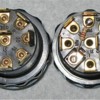I just noticed that the light from my flasher when the car lights are on, is ridiculously bright.
It is a replacement unit and does not have the soldered in resistor that the car's original did.
The light terminal seems to be 34b?
I presume that others have had issue with this?
Can I put a resistor in line to 34b and if so anyone know the value of it?
This thing is much too bright as it is now. It is dangerously distracting.
Original Post


